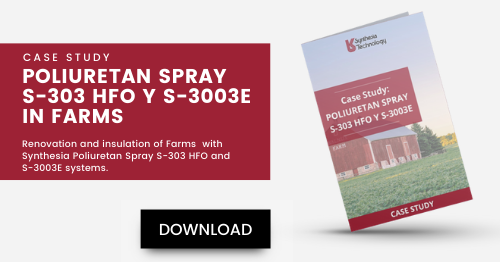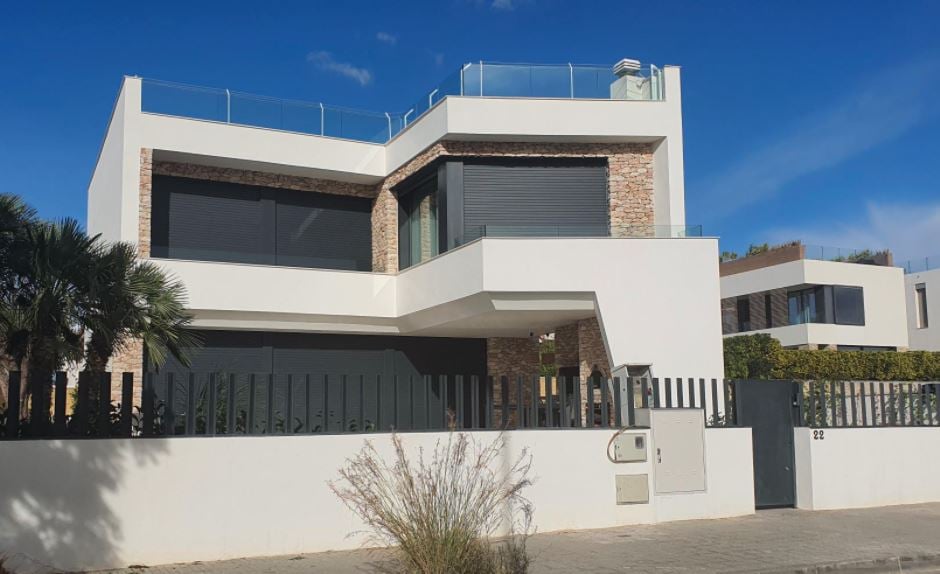The insulation of animal farms is a growing phenomenon. Farmers in different countries around the world are becoming more and more aware of its great benefits at all levels. We analyse the case of different livestock farms whose facilities have been insulated and renovated with Synthesia’s system Poliuretan Spray S-303 HFO and Poliuretan Spray S3003E.
/Casos%20de%20%C3%A9xito/08.%20Caso%20de%20estudio%20-%20Poliuretan%20Spray%20S-303%20HFO%20y%20S-3003E/Fotos/20210729_113130.jpg?width=750&name=20210729_113130.jpg)
Products Description
Poliuretan Spray S-303 HFO is a two-component polyurethane system, polyol and isocyanate, applied by "in situ" spraying to obtain rigid closed-cell foams for thermal insulation. This product has been developed using Hydrofluoro-Olefins (HFO), a 4th generation foaming agent, which leads to very low global warming, containing recycled PET and products of renewable origin in its composition. The polyol component of the Poliuretan Spray S-303 HFO system is manufactured with:
12% recycled PET
10% Products of renewable origin
In the case of one of the analysed chicken farms (images 1 and 2), the total calculation of PET recycled used by applying Poliuretan Spray S-303 HFO is equivalent to a total of PET bottles (50cl) of 5,000 PET bottles recycled.
Poliuretan Spray S-3003E is a two-component, polyol and isocyanate, closed-cell, rigid polyurethane foam system. It is an in-situ spray-applied system for thermal insulation protection, formulated with water as a foaming agent and, therefore, does not contribute to global warming.
As can be seen in the pictures, the roof of one of the farms showed great wear and tear over time and use.
/Casos%20de%20%C3%A9xito/08.%20Caso%20de%20estudio%20-%20Poliuretan%20Spray%20S-303%20HFO%20y%20S-3003E/Fotos/20210729_121505.jpg?width=750&name=20210729_121505.jpg)
The importance of insulation in animal farms
The farm facilities with animals inside must have thermal insulation in order to carry out the breeding process efficiently and cost-effectively. It is very important to highlight the economic cost of having a shed with an inadequate level of insulation. This economic quantification must be evaluated taking into account the three main consequences of an efficient insulation:
▪ Energy saving: A minimum breeding temperature is required on farms (for example, in the case of chicken breeding, it must be above 30ºC). As the breeding do not yet generate enough heat, this must be provided by heating to counteract heat loss through the enclosures. The worse insulated a farm is, higher the energy costs, so it is advisable to analyse the level of insulation in order to quantify the costs of airconditioning.
▪ Improvement of environmental quality: In a poorly insulated farm facilities and in cold periods, if heat losses are not compensated by heating, ventilation is usually reduced to a minimum in order to reach the recommended temperature. This situation is particularly serious for some animals such as poultry, where low ventilation rates favour an increase in humidity. In addition, damp litter leads to increased ammonia release, resulting in a higher incidence of respiratory and metabolic disorders in the animals.
▪ Lower feed consumption: In a poorly insulated farm facilities and in cold periods, the animals do not generate enough heat to counteract heat loss through the enclosures. Therefore, if adequate ventilation is desired and is not compensated by heating, it will be difficult to achieve adequate temperatures. The consequence is that the animal has to consume more feed to try to compensate for its body heat needs.
Benefits of insulation on farms with Synthesia Poliuretan Spray S-303 HFO and Poliuretan Spray S-3003E products:
- Animals (pigs, poultry, cattle, etc.) have improved comfort and environmental welfare (according to the Animal Protection and Welfare Code - updated edition of March 9, 2022).
- Reduced energy consumption for maintenance and reduced food and water consumption, thus drastically reducing the fixed costs of these services.
- The application of our products allows the development of this type of facilities in areas with very extreme climatology and thus reduces heating costs.
- Protection of metal structures from direct contact with corrosive substances that come from slurry (Example: ammonia).
- Allows the cleaning of farms in a very fast and effective way with methods such as pressurized water.
- With Synthesia systems, the insulation is protected from small animals and rodents that can damage the structure and deteriorate it, thus extending its useful life.
- Increased production: a farm with Synthesia’s 6 cm polyurethane insulation solution can achieve an increase in pig farming production of 15% or, in some cases, more, according to our customers’ experience.
/Casos%20de%20%C3%A9xito/08.%20Caso%20de%20estudio%20-%20Poliuretan%20Spray%20S-303%20HFO%20y%20S-3003E/Fotos/20190621_110116.jpg?width=750&name=20190621_110116.jpg)
Preparation and application
Surfaces must be clean, dry and free of dust and grease to ensure good adhesion of the foam to the substrate; if the substrate is metallic, it must also be free of oxide and rust. Under favourable conditions, Poliuretan Spray foams have good adhesion to most of the materials used in construction.
The recommended hose temperature for both products is 30 to 50ºC, depending on environmental conditions.
The minimum recommended substrate temperature during spraying is 5ºC
Application with Poliuretan Spray S-303 HFO:
The Poliuretan Spray S-303 HFO system has an insulating function and is applied by spraying with high-pressure equipment, endowed with heating, with a mixing ratio of 1:1 in volume. Its main applications are the thermal insulation of facades and roofs on the inside. Its applied density is 35-45 g/l.
The thickness of the layer is perfectly controllable and can be modified by varying the application speed and/or the mixing chamber of the spray gun; this thickness should be between 10 to 20 mm.
It should be noted that the higher the foam performance, the lower the number of layers for the same thickness. However, it is not advisable to apply thicknesses greater than 20 mm. to avoid the formation of blisters, problems due to the high exothermicity of the reaction and to maintain the properties of the foam.
Application of Poliuretan Spray S-3003E:
The Poliuretan Spray S-3003E system has a protective function and is applied by projection with high pressure equipment, endowed with heating, with a mixing ratio of 1:1 in volume.
It is mainly used in decoration, finishing, highdensity insulation and foam protection. The recommended thickness in each application for good foam performance is 5-10 mm.
Final result
Spray application allows to coat areas with an irregular surface or areas of very complicated geometry, forming a uniform film and providing thermal and acoustic insulation to the entire structure, as well as great protection against wear, leaks and dampness.
/Casos%20de%20%C3%A9xito/08.%20Caso%20de%20estudio%20-%20Poliuretan%20Spray%20S-303%20HFO%20y%20S-3003E/Fotos/20190621_114046.jpg?width=4608&name=20190621_114046.jpg)





.jpg)






